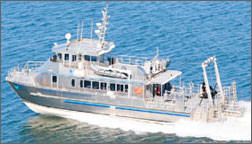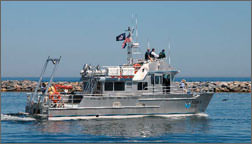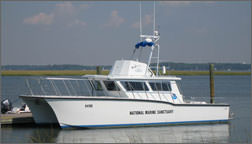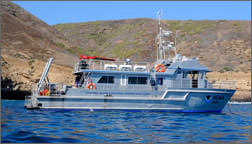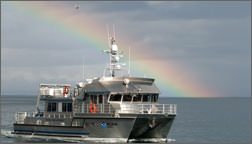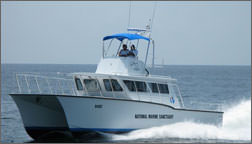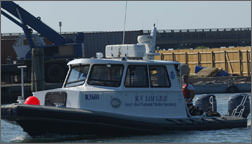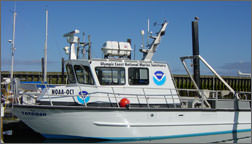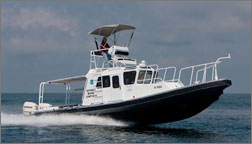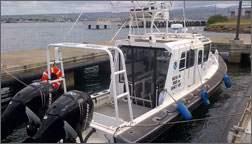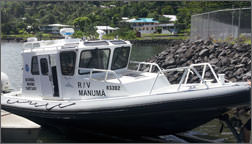Small Boat Fleet
Every national marine sanctuary relies on small boats to access protected areas. This access is necessary for sanctuaries to implement our management plans, each of which addresses unique local challenges and opportunities. ONMS currently maintains and operates more than 40 vessels ranging from small tenders or utility boats to larger regional class boats up to 85 feet in length.
Small Research Vessel (SRV)
These regional boats support sanctuaries' resource protection mission, especially in remote or high sea state areas. They fill the gap between operations suitable for smaller classes of sanctuary vessels and those performed using larger NOAA multipurpose coastal research ships.
EASTERN REGION
Manta: The Manta is an 83 foot NOAA SRV class boat that supports operations at Flower Garden Banks National Marine Sanctuary. It has a range of 600 nm and a cruising speed of 27 knots. It requires four crew and can accommodate 10 passengers for up to five days (overnight). For single day missions, two to three crew are required and the vessel can accommodate up to 26 total passengers. The Manta supports research, education, and diving activities. It was built in 2007 and is home ported in Galveston, TX. Click here for more information.
Class III Boats
Stellwagen Bank National Marine Sanctuary
Auk: The Auk is a 50 foot NOAA class III boat that supports a range of operations at Stellwagen Bank National Marine Sanctuary. It has a range of 400 nm and a cruising speed of 20 knots. It requires two crew and can accommodate 12 passengers for day trips and four to six passengers for overnight trips. It was built in 2006. Its primary uses are for research, education, diving, and enforcement. Its home port is located at Scituate, MA.
Gray's Reef National Marine Sanctuary
Joe Ferguson: The Ferguson is a 41 foot NOAA class III boat that supports operations at Gray's Reef National Marine Sanctuary. It has a range of 350 nm and a cruising speed of 25 knots. It requires two crew and can accommodate 12 passengers for day trips and two to three passengers for overnight trips. It was built in 2008. It is used for research, diving, and buoy maintenance. Its home port is located in Savannah, GA.
West Coast Region
Channel Islands National Marine Sanctuary
Shearwater: The Shearwater is a 62 foot NOAA class III boat that supports operations at Channel Islands National Marine Sanctuary. It can work up to 180 days per year. It has a range of 400 nm and a cruising speed of 19 knots. It requires 2 to 3 crew and can accommodate up to 28 passengers for day trips and six passengers for up to five days overnight. It supports research, education, and diving activities. It includes a Bauer air compressor to support diving operations. It was built in 2002 and is home ported in Santa Barbara, CA.
2012 Accomplishments Report
Fulmar: The Fulmar is a 67 foot NOAA class III boat. It has a range of 400 nm and a cruising speed of 22 knots. The vessel was built in 2006 and home ported at the Monterey Harbor in Monterey Bay National Marine Sanctuary. It also serves the Gulf of the Farallones and Cordell Bank national marine sanctuaries. It accommodates two to three crew, up to 27 passengers, and includes 10-12 berths. It was built in 2006 and is home ported in Monterey, CA.
2012 Accomplishments Report
R-4107: The 4107 is a 41 foot NOAA class III boat. It has a range of 300 nm and a cruising speed of 28 knots. The vessel was built in 2008 and home ported at the Monterey Harbor in Monterey Bay National Marine Sanctuary. It has a day trip capacity for 10 and overnight capacity for four. It serves Monterey Bay, Gulf of the Farallones, and Cordell Bank national marine sanctuaries.
Class II Boats
EASTERN REGION
Gray's Reef National Marine Sanctuary
Sam Gray: The Sam Gray is a 36 foot NOAA class II boat that supports operations at Gray's Reef National Marine Sanctuary. It has a range of 250 nm and a cruising speed of 35 knots. It requires two crew and can accommodate six passengers for day trips. The boat can be trailered to alternative locations. It was built in 2004. The Gray suports research and diving activities. Its home port is located in Savannah, GA.
Florida Keys National Marine Sanctuary
Florida Keys National Marine Sanctuary maintains a fleet of Class I & II vessels that support operations across the 2,900 square nautical miles of sanctuary waters. Seven boats are stationed in Key Largo and seven in Key West.
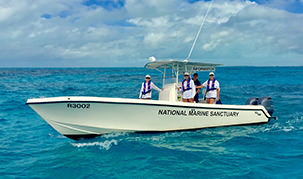
R3002 SeaVee: The SeaVee staged in Key Largo, is a 30-foot monohull used to support science operations, and by partner agencies to conduct annual coral and seagrass monitoring.
R3007 Manta: The Manta, staged in Key Largo, is a 30-foot monohull used for buoy and science operations.
R3008 Manta: The Manta, staged in Key West, is a 30-foot monohull used for buoy operations when limited crew is available. This boat is also used as an alternate for science operations.
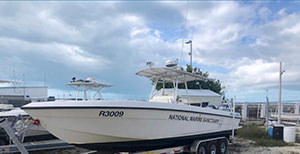
R3009 Manta: The Manta, staged in Key West, is a 30-foot monohull used to support science operations, and by partner agencies to conduct annual coral and seagrass monitoring.
R3010 Manta: The Manta, staged in Key West, is a 30-foot monohull with larger fuel tanks for long-range operations including the Tortugas Ecological Reserve and other areas that are at the outer edge of the sanctuary boundary. This boat allows for concurrent operations on good weather days.
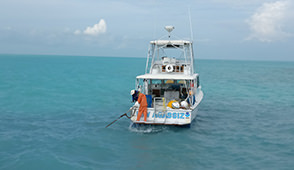
R3902 R/V Agassiz: The Agassiz, staged in Key Largo, is a 39-foot inboard, diesel-powered boat used to maintain the eastern portion of the sanctuary’s nearly 900 marker and mooring buoys. Operations include buoy installation, inspection and maintenance involving working dives and, at times, hydraulic tools to install anchors into the sea floor. This boat also supports scientific operations.
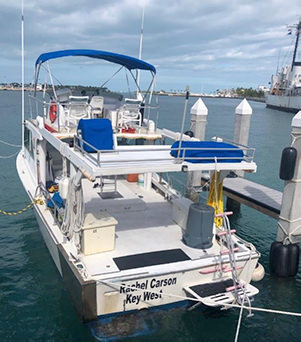
R3903 R/V Rachel Carson: The Rachel Carson, staged in Key West, is 39-foot inboard, diesel-powered boat used to maintain the western portion of the sanctuary’s nearly 900 marker and mooring buoys, including the Tortugas Ecological Reserve. Operations include buoy installation, inspection and maintenance involving working dives and, at times, hydraulic tools to install anchors into the sea floor. This boat also supports scientific operations.
Mooring buoys installed and maintained by the R/V Agassiz and R/V Rachel Carson in Florida Keys National Marine Sanctuary (FKNMS) make it possible for boaters to enjoy the sanctuary without damaging the fragile coral reefs. There are currently more than 500 mooring buoys available for use within the sanctuary on a first-come. The moorings allow a boater to tie off, eliminating the need to anchor on sensitive habitats. These buoys prevent damage caused by anchors and chains when in contact with the coral reef. These buoys also serve as designation sites, flagging popular dive and snorkel locations for a visiting tourist. It’s a win -win scenario for both the boater and the resources (both natural and cultural).
West Coast Region
Olympic Coast National Marine Sanctuary
Tatoosh: The Tatoosh is a 38 foot NOAA class II boat. It has a range of 300 nm and is home ported in Port Angeles, WA, working out of La Push or Neah Bay, WA during the field season. It was built in 1994 and can operate up to 120 days per year. It supports research activities in Olympic Coast National Marine Sanctuary.
Channel Islands National Marine Sanctuary
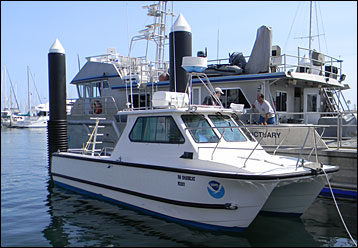
Shark Cat: The RV Sharkcat is a NOAA Class II, 28’ catamaran, power-cruiser. It is primarily used to conduct biotic and abiotic oceanographic research in the waters of the Santa Barbara Channel and Channel Islands in Southern California. Oceanographic research includes SCUBA diving, mapping the ocean floor, small-scale remotely-operated vehicle support, and sampling of the water, air,earth and marine organisms. Further, the vessel is used in emergency response when needed to protect sanctuary resources and also maritime heritage or archeological and cultural research. The vessel can operate near coastal or in open waters depending on sea state with a complement of 4-6 scientists and two crew while traveling at a cruising speed of 20-25KTS for 180-200NM before returning to its home port of Santa Barbara, CA. It was built in 1986 by Noosa Cat (Australia).
Pacific Islands Region
Hawaiian Islands Humpback Whale National Marine Sanctuary
Koholā: The Koholā is a 38 foot NOAA class II boat. It has a range of 200 nm and a maximum speed of 25 knots. It was built in 2011 and accommodates one to two crew and nine to 10 passengers. The vessel was specifically built and customized for large whale response, disentanglement and research. Based in the heart of the sanctuary, the vessel's homeport will be primarily in Maui at Mā'alaea Harbor.
Description
Papahānaumokuākea Marine National Monument
Hīhīmanu: The Hīhīmanu is a 36 foot NOAA class II boat. It has a range of 200 nm and a maximum speed of 25 knots. It was built in 2007 and is home ported at NOAA Inouye Regional Center at Ford Island in Pearl Harbor, Hawaii. It accommodates one to two crew and 9 to 10 passengers. This research vessel is the primary technical dive platform for tri-mix and rebreather training and proficiency dives. It is also used for education, outreach and research operations.
National Marine Sanctuary of American Samoa
Manuma: The Manuma is a 33 foot NOAA class II boat. It has a range of 205 nm and a maximum speed of 40 knots. It was built in 2007 and is home ported in Pago Pago, American Samoa. It accommodates one to two crew and 4 to 5 passengers.
Class I Boats
eastern Region
Florida Keys National Marine Sanctuaries
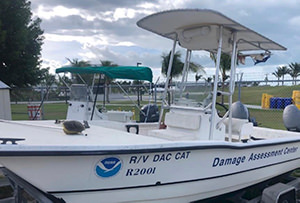
R2001 Dacat: The Dacat, staged in Key West, is a 20-foot fiberglass catamaran boat used for shallow water damage assessments, and field support for shoreline cleanups when using kayaks.
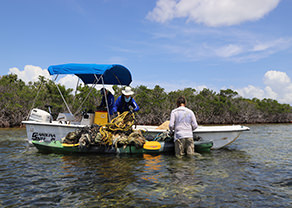
R2002 Carolina Skiff: The Carolina Skiff, staged in Key Largo, is a 20-foot flat bottom open boat with very shallow draft used for research, damage assessments, and field support for shoreline cleanups when using kayaks. By utilizing the Carolina Skiff, Goal: Clean Seas Florida Keys, the marine debris cleanup program run by Florida Keys National Marine Sanctuary, removed over 10,000 lbs of trash from sanctuary waters in its first year.
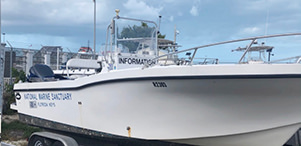
R2303 Dusky: The Dusky, staged at Bahia Honda State Park, is a 23-foot monohull used by Team OCEAN to educate boaters on sanctuary regulations and proper use of mooring buoys.
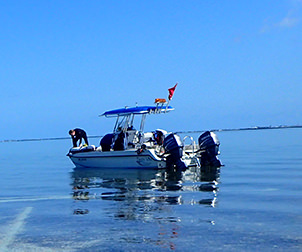
R2204 Twin Vee: The Twin Vee, staged in Key Largo, is a 22-foot fiberglass catamaran used to conduct shallow water maintenance of marker buoys, damage assessment, remote sensing and historical resource research.
R2303 Pro Line: The Pro Line, staged in Key West, is a 23-foot monohull used by Team OCEAN to educate boaters on sanctuary regulations and proper use of mooring buoys.
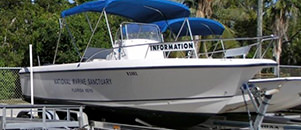
R2402 Pro Line: The Pro Line, staged in Key Largo, is a 24-foot monohull used by Team OCEAN to educate boaters on sanctuary regulations and proper use of mooring buoys.
R2509 Frontier Whaler: The Frontier Whaler, staged in Key West, Is a 25-foot closed cabin monohull that allows for use of salt-sensitive oceanographic instruments. Its side access door can be utilized for diver rescue, equipment deployment and other surface operations. This boat is also used to install buoys in shallow water and when shuttling the Rachel Carson
R2509 Frontier Whaler: The Frontier Whaler, staged in Key West, Is a 25-foot closed cabin monohull that allows for use of salt-sensitive oceanographic instruments. Its side access door can be utilized for diver rescue, equipment deployment and other surface operations. This boat is also used to install buoys in shallow water and when shuttling the Rachel Carson
Specialty Vessels
Thunder Bay National Marine Sanctuary
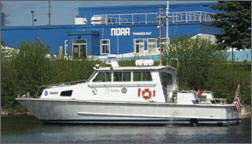
Storm: The 50 foot RV Storm is operated by NOAA's Great Lakes Environmental Research Lab (GLERL) and is dedicated to supporting Thunder Bay National Marine Sanctuary. RV Storm was completely refitted in 2009-10. Special emphasis was placed on versatility to best support the sanctuary's diverse interests and projects The Storm operates about 70 days a year in the sanctuary.


